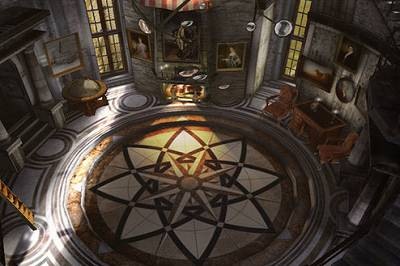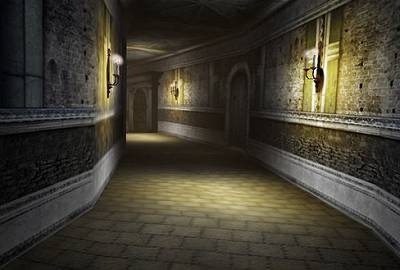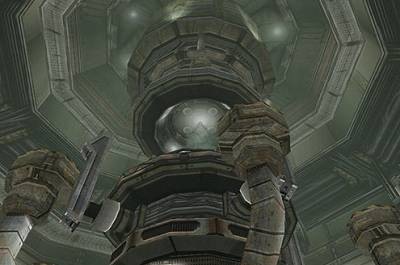Clive Jackson is the CEO and Founder of Pelikan Crossing, the company behind two revolutionary products: Blink3D and inDuality.
Blink3D is a platform for creating multi-user Web based virtual worlds and 3D environments, that allows you to model virtual worlds graphically (but also provides an editor for programmers).
inDuality is an universal client that allows you to travel from one virtual world to another from inside your browser, thus making possible to go from one platform to another seamlessly, and certainly suppose an astonishing advance in cross-gaming.
In this interview, you will explore the many possibilities that Pelikan Crossing has to offer, for now, and for the future.
 Copyrighted photo authorized by Clive Jackson
Copyrighted photo authorized by Clive Jackson
- Is Blink3D specially aimed for a particular type of virtual worlds?
- Blink 3D is a virtual world development platform, it is not in its self a virtual world. It was designed to be used by professionals and non-professionals a like, who maybe be graphically challenged or programmatically challenged or both. Blink 3D plays to your skills and assists in areas where you are not as strong. Virtual worlds created with Blink 3D typically run on a Web page and download fairly quickly. Designers have the ability to load and unload sections of the virtual world which means that in theory, the world can go on forever. The hardware requirements for Blink 3D virtual worlds are minimal as the virtual world actually runs on the users machine not on a server. A Web server is required to serve up the world and and optional XMPP server is needed for the multi-user aspects. The XMPP server can easily run on the same machine as the Web server. Open source versions of the XMPP server are freely available and can be installed in a few minutes.
Because with Blink 3D you can control every aspect of the virtual world from look and feel to branding and advertising to access control, they are ideally suited for use on corporate Web sites. Virtual worlds created with Blink 3D are popular for education, virtual heritage as well as the more traditional virtual worlds. Here are some screen shots of some Blink 3D virtual worlds created by our users: http://www.flickr.com/groups/741893@N24/ and also some videos of those worlds: http://www.youtube.com/PelicanCrossingInc
- Why did you choose Ogre as graphics rendering engine?
- There was no point in reinventing the wheel so we spent a lot of time looking at the various 3D engines that were out there and we had a big requirements list. With Ogre we were able to put a check mark next to every requirement. While a lot of our requirements were to satisfy our own internal needs, at the end of the day it's a question of what does it mean to the virtual world developer and end user. Ogre is fast emerging as and open standard, with a number of virtual world companies following our lead including RealXtend and Multiverse. This means that there are a lot more tools coming on line, support from third parties and a rapidly growing knowledge base. For the virtual world developer, they have access to a very fast rendering engine with all the bells and whistles you would expect . For the end user they get a drop dead gorgeous looking virtual world that works well on their system.

Copyrighted photo authorized by Clive Jackson
- Can X3D be used/imported into Blink3D, or will it be in the future?
- There is no ability to load X3D files directly and there are no plans for this in the foreseeable future. However, it may be possible to import X3D models into modeling products such as 3ds Max, Maya, XSI, Houdini, AC3D and Blender, etc. and then export into the Ogre mesh format that Blink 3D uses. It's likely that the original X3D model was created with one of these modeling products anyway, so rather than exporting as X3D simply export in Ogre .mesh format. We are also looking at supporting Collada which may make this process a bit smoother.
- inDuality's purpose is to be a bridge for browsing from one virtual worlds platform to another seamlessly. What does this suppose for the users, how does it improve their experience?
- inDuality offers the users an number of things. Firstly it allows non Web based virtual worlds like Second Life to run in a Web browser. This means that via inDuality the Web sites can tightly integrate with it. The Web site can drive SL and SL can drive the Web page. What I mean by this is that one can be used to control or alter the look of the other in a real time seamless integration
Secondly, inDuality provides a single simplified way to manage all of the different technologies needed to view the various virtual worlds and 3D environments that exist today. The goal here is that you install inDuality once and then inDuality will take care of ensuring that the appropriate extension is installed and up to date in order to render the 3D content on the current Web page. Right now people don't worry about their Web browsers ability to render the different Web sites they visit. The same needs to be true of 3D content on the Web. If the user is forced to install new plug-ins or updates it's a constant slap in the face, and is a severe barrier to entry for any Web site wishing to leverage 3D content. If inDuality seamlessly takes care of all this for the user they are far more inclined to explore. Remember the days of dial up Web access. Because it took so long for things to download people were hesitant to click on a link for fear it was the wrong one. With broadband access people explore more because there is a minimal time penalty, and with inDuality people will be more inclined to explore the 3D Web.
Thirdly with inDuality, it means that all the differing virtual worlds out there can be linked into a cohesive whole, the Metavase. Right now the virtual worlds and 3D content are in walled off islands, inDuality does not tear down the walls, the 3D content is still behind the walls but inDuality does provide a way for users to pass through the walls to visit. The thing with inDuality is that you can move from one virtual world to another without the actual Web page changing. So on your Facebook page you can use inDuality to embed your favorite virtual world, lets say Second Life. People can visit your page, enter Second Life at the point you specified and then be able to teleport to other other locations inside Second Life or to virtual worlds created with a different product, and no matter where they go in the Metaverse they are still on your Facebook page. This is of course is ideal for people who have a branded page or a page with adverts.
We have other features planned such as meta chat which will allow you to chat with your friends when they are in different virtual worlds to you, or to locate which virtual world your friends are in and teleport to them or to be notified when a friend enters a virtual world.
 Copyrighted photo authorized by Clive Jackson
Copyrighted photo authorized by Clive Jackson
- In your site, you say that inDuality supports Second Life, which means that users can embed SL worlds directly on web pages. How can users do this? Do they have to insert some special code or how?
- The Second Life extension for inDuality is in alpha right now, but when it's released all they would need to do would be to place a JavaScript file called inDuality.js on their Web site. Then add some simple code to the Web page that they want Second Life to be embedded in. Here is a basic example:
<html xmlns="http://www.w3.org/1999/xhtml" xml:lang="en" lang="en">
<head>
<title>inDuality</title>
<meta http-equiv="Content-Type" content="text/html; charset=iso-8859-1"/>
<script src='inDuality.js'></script>
<script>validateBrowserOS();</script>
</head>
<body leftmargin='0' topmargin='0' scroll='no' >
<script>
var oCtrl = new inDualityControl();
oCtrl.pluginVersion = "2,0,0,156";
oCtrl.width = "100%";
oCtrl.height = "100%";
oCtrl.addProperty( "ContentType", "SecondLife" );
oCtrl.addProperty( "WorldURL", "IBM BUSINESS CENTER#127/101/23" );
oCtrl.addProperty( "Server", "agni" );
oCtrl.create();
</script>
<noscript>
JavaScript must be enabled to use this page <br/>
</noscript>
</body>
</html>
- With an inDuality client embedded in a page, can the visitors travel from a SL world, for example, to a X3D world seamlessly?
- To have this be completely seamless the different virtual world vendors will need to add support for inDuality portals into their product which is quite easy to do. In the meantime Blink 3D supports inDuality portals so you can go from a Blink 3D world to Second Life or from Blink 3D to X3D. inDuality has a toobar with Previous, Next and Home buttons which work the same as they do in a Web Browser. So clicking on the Back button when in an X3D world will take you back to the world you were in previously. People can use the free Ultra Lite edition of Blink 3D to create hub portals with links to other Blink 3D or non Blink 3D virtual worlds and then embed it in their Facebook or MySpace page. Essentially they could create something that might look like this: http://www.pelicancrossing.com/images/inDuality/inDualityPortalLrg.jpg As other virtual worlds vendors add in support for inDuality portals you will be able to create hub portals with their products as well. Once this point is reached users will be able to move through the Metaverse even easier.
- Is inDuality available for download? When will it be released?
- inDuality is available for download now and was released in June 2008. However, the only 3D content that's currently supported is Blink 3D. While internally we have inDuality extensions for Second Life, X3D and Flash working we have delayed releasing them while we expand the concept of inDuality, which has gone from just inDuality the client to inDuality the platform. We will be releasing more details about this in due course.
- Most virtual worlds try to "rule the world" and dominate the market, while others are heading towards collaboration. What role does inDuality play in all these emerging technologies and their relationships?
- We are certainly on the collaboration side, we are not egotistical enough to believe that the whole world will only want to use virtual worlds created with Bink 3D. There are lots of different types of virtual worlds out there with more to come, each has its strengths and weaknesses. As I point out in out in the white paper The Metaverse 2.0 http://www.pelicancrossing.com/WhitePapers/TheMetaverse20.pdf, I believe that the Metaverse will not be dominated by a single vendor, rather it will consist of a vast collection of interconnected virtual worlds created using different virtual world technologies. This is starting to happen today, there are more virtual worlds coming on line using different technologies. The problem remains though, how do you move between these walled virtual world islands? This is where inDuality comes in, it will allow all these islands to be interconnected to form the bigger Metaverse. One way to look at this is to think of the different countries in the real world as virtual world walled gardens, and to think of planes as inDuality, essentially the means to go from one country/walled garden to another. For me one, of the great things about travel is experiencing the different climates, scenery, architecture and cultures in the world. The promise of inDuality is to allow you to experience some of the same things but in the Metaverse.
© by Jordi R. Cardona. Link to this post without copying the text.
If you liked this post, get updates of Hiperia3D News for FREE







 Hiperia3D News is a Netbeans Community Partner, in recognition for developing the
Hiperia3D News is a Netbeans Community Partner, in recognition for developing the 


Be the first to comment!
Post a Comment